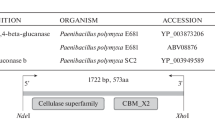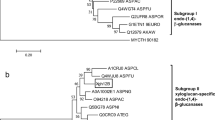Abstract
A bacterial strain Paenibacillus polymyxa GS01 was isolated from the interior of the roots of Korean cultivars of ginseng (Panax ginseng C. A. Meyer). The cel44C-man26A gene was cloned from this endophytic strain. This 4,056-bp gene encodes for a 1,352-aa protein which, based on BLAST search homologies, contains a glycosyl hydrolase family 44 (GH44) catalytic domain, a fibronectin domain type 3, a glycosyl hydrolase family 26 (GH26) catalytic domain, and a cellulose-binding module type 3. The multifunctional enzyme domain GH44 possesses cellulase, xylanase, and lichenase activities, while the enzyme domain GH26 possesses mannanase activity. The Cel44C enzyme expressed in and purified from Escherichia coli has an optimum pH of 7.0 for cellulase and lichenase activities, but is at an optimum pH of 5.0 for xylanase and mannanase activities. The optimum temperature for enzymatic activity was 50°C for all substrates. No detectable enzymatic activity was detected for the Cel44C-Man26A mutants E91A and E222A. These results suggest that the amino acid residues Glu91 and Glu222 may play an important role in the glycosyl hydrolases activity of Cel44C-Man26A.





Similar content being viewed by others
References
Ahsan MM, Kimura T, Karita S, Sakka K, Ohmiya K (1996) Cloning, DNA sequencing, and expression of the gene encoding Clostridium thermocellum cellulase CelJ, the largest catalytic component of the cellulosome. J Bacteriol 178:5732–5740
Ali BRS, Romaniec MPM, Hazlewood GP, Freedman PB (1995) Characterization of the subunits in an apparently homogeneous subpopulation of Clostridium thermocellum cellulosomes. Enzyme Microb Technol 17:705–711
Al-Mallah MK, Davey MR, Cooking EC (1987) Enzymatic treatment of clover root hairs removes a barrier to Rhizobium-host specificity. Biotechnology 5:1319–1322
An JM, Kim YK, Lim WJ, Hong SY, An CL, Shin EC, Cho KM, Choi BR, Kang JM, Lee SM, Kim H, Yun HD (2005) Evaluation of a novel bifunctional xylanase–cellulase constructed by gene fusion. Enzyme Microb Technol 36:989–995
Arai T, Araki AR, Tanaka A, Karita S, Kimura T, Sakka K, Ohmiya K (2003) Characterization of a cellulase containing a family 30 carbohydrate binding module (CBM) derived from Clostridium thermocellum CelJ: importance of the CBM to cellulase hydrolysis. J Bacteriol 185:504–512
Ash C, Farrow JA, Priest FG, Collins MD (1993) Molecular identification of rDNA group 3 bacilli (Ash, Fallow, Wallbanks, Collins) using a PCR probe test: proposal for the creation of a new genus Paenibacillus. Antonie Van Leeuwenhoek 64:253–260
Avitia CI, Castellanos-Juárez FX, Sánchez E, Téllez-Valencia A, Farardo-Cavazos P, Nicholson WL, Pedraza-Reyes M (2000) Temporal secretion of a multicellulolytic system in Myxobacter sp. AL-1. Molecular cloning and heterologous expression of cel9 encoding a modular endocellulase clustered in an operon with cel48, an exocellobiohydrolases gene. Eur J Biochem 267:7058–7064
Chen JL, Tsai LC, Wen TN, Tang JB, Yuan HS, Shyur LF (2001) Directed mutagenesis of specific active site residues on Fibrobacter succinogenes 1,3-1,4-β-D-glucanase significantly affects catalysis and enzyme structural stability. J Biol Chem 276:17895–17901
Cho SJ, Park SR, Kim MK, Lim WJ, Ryu SK, An CL, Hong SY, Lee YH, Jeong SG, Cho YU, Yun HD (2002) Endophytic Bacillus sp. isolated from the interior of balloon flower root. Biosci Biotechnol Biochem 66:1270–1275
Choi O, Kim J, Ryu CM, Park CS (2004) Colonization and population changes of a biocontrol agent, Paenibacillus polymyxa E681, in seeds and roots. Plant Pathol J 20:97–102
Dijksterhuis JM, Gorris Sanders LG, Smid EJ (1999) Antibiosis plays a role in the context of direct interaction during antagonism of Paenibacillus polymyxa towards Fusarium oxysporum. J Appl Microbiol 86:13–21
Foong F, Hamamoto T, Shoseyov O, Doi RH (1991) Nucleotide sequence and characteristics of endoglucanase gene engB from Clostridium cellulovorans. J Gen Microbiol 137:1729–1736
Gibbs MD, Saul DJ, Luthi E, Bergquist PL (1992) The β-mannanase from “Caldocellum saccharolyticum” is part of a multidomain enzyme. Appl Environ Microbiol 58:3864–3867
Gibbs MD, Reeves RA, Farrington GK, Anderson P, Williams DP, Bergquist PL (2000) Multidomain multifunctional glycosyl hydrolasess from the extreme thermophile Caldicellulosiruptor isolate Tok7B.1. Curr Microbiol 40:333–340
Gosalbes MJ, Perez-Gonzalez JA, Gonzalez R, Navarro A (1991) Two β-glycanase genes are clustered in Bacillus polymyxa: molecular cloning, expression, and sequence analysis of genes encoding a xylanase and an endo-β-(1,3)-(1,4)-glucanase. J Bacteriol 173:7705–7710
Hallmann J, Quardt-Hallmann A, Mahaffee WF, Kloepper JW (1997) Bacterial endophytes in agricultural crops. Can J Microbiol 43:895–914
Hansen CK, Diderichsen B, Jorgensen PL (1992) celA from Bacillus lautus PL236 encodes a novel cellulose binding endo-β-1,4-glucanase. J Bacteriol 174:3522–3531
Henke JM, Bassler BL (2004) Bacterial social engagements. Trends Cell Biol 14:649–655
Henrissat B, Teeri TT, Warren RAJ (1998) A scheme for designating enzymes that hydrolases the polysaccharides in the cells of plants. FEBS Lett 425:352–354
Huan JS (1986) Ultrastructure of bacterial penetration in plants. Annu Rev Phytopathol 24:141–157
Hurek T, Van Reinhold-Hurek B, Montagu M, Lellenberger E (1994) Root colonization and systemic spreading of Azoarcus sp. strain BH72 in grasses. J Bacteriol 176:1913–1923
Jeon YH, Chang SB, Hwang IG, Kim YH (2003) Involvement of growth-promoting rhizobacterium Paenibacillus polymyxa in root rot of stored Korean ginseng. J Microbiol Biotechnol 13:881–891
Kataeva IA, Ronald DS, Ashit S, Larry TW, Xin-Liang L, Lars GL (2002) The fibronectin type 3-like repeat from the Clostridium thermocellum cellobiohydrolases CbhA promotes hydrolysis of cellulose by modifying its surface. Appl Environ Microbiol 68:4292–4300
Kimoto H, Kusaoke H, Yamamoto I, Fujii Y, Onodera T, Taketo A (2002) Biochemical and genetic properties of Paenibacillus glycosyl hydrolases having chitosanase activity and discoidin domain. J Biol Chem 277:14695–14702
Lebuhn M, Heulin T, Hartmann A (1997) Production of auxin and other indolic compounds by Paenibacillus polymyxa strains isolated from different proximity to plant roots. FEMS Microbiol Ecol 22:325–334
Lee SW, Won K, Lim HK, Kim JC, Choi GJ, Cho KY (2004) Screening for novel lipolytic enzymes from uncultured soil microorganisms. Appl Microbiol Biotechnol 65:720–726
Lim WJ, Hong SY, An CL, Cho KM, Choi BR, Kim YK, An JM, Kang JM, Lee SM, Cho SJ, Yun HD (2005) Construction of minimum size cellulase (Cel5Z) from Pectobacterium chrysanthemi PY35 by removal of the C-terminal region. Appl Microbiol Biotechnol 68:46–52
Lima AOS, Quecine MC, Fungaro MHP, Andreote FD, Maccheroni Jr W, Araújo WL, Silva-Filho MC, Pizzirani-Kleiner AA, Azevedo JL (2005) Molecular characterization of a β-1,4-endoglucanase from an endophytic Bacillus pumilus strain. Appl Microbiol Biotechnol 68:57–65
Little E, Bork P, Doolittle RF (1994) Tracing the spread of fibronectintype III domain in bacterial glycohydrolases. J Mol Evol 39:631–643
Miller GL (1959) Use of dinitrosalicylic acid reagent for the determination of reducing sugar. Anal Chem 31:426–428
Nielsen P, Sørensen J (1997) Multi-target medium-independent fungal antagonism by hydrolytic enzymes in Paenibacillus polymyxa and Bacillus pumilus strains from barley rhizosphere. FEMS Microbiol Ecol 22:183–192
Pastor FIJ, Pujol X, Blanco A, Vidal T, Torres AL, Diaz P (2001) Molecular cloning and characterization of a multidomain endoglucanase from Paenibacillus sp BP-23: evaluation of its performance in pulp refining. Appl Microbiol Biotechnol 55:61–68
Quadt-Hallmann A, Benhamou AN, Kleopper JW (1997) Bacterial endophytes in cotton: mechanisms of entering the plant. Can J Microbiol 43:577–582
Quillet L, Barray S, Labedan B, Petit F, Guespinmichel J (1995) The gene encoding the b-1,4-endoglucanase (Cela) from Myxococcus xanthus-evidence for independent acquisition by horizontal transfer of binding and catalytic domains from Actinomycetes. Gene 158:23–29
Rosado AS, Seldin L (1993) Production of a potentially novel anti-microbial substance by Bacillus polymyxa. World J Microbiol Biotechnol 9:521–528
Sambrook J, Russel DW (2001) Molecular cloning: a laboratory manual, 3rd edn. Cold Spring Harbor Laboratory, Cold Spring Harbor, NY
Sanz-Aparzicio J, Hermoso JA, Martinez-Ripoll M, Lequerica JL, Polaina J (1998) Crystal structure of beta-glycosidase A from Bacillus polymyxa: insights in to the catalytic activity in family 1 glycosyl hydrolases. J Mol Biol 275:491–502
Smith JD, Barnett L, Brenner S, Russell RL (1970) More mutant tyrosine transfer ribonucleic acids. J Mol Biol 54:1–14
Timmusk S, Grantcharova N, Wagner EGH (2005) Paenibacillus polymyxa invades plant roots and forms biofilms. Appl Environ Microbiol 71:7292–7300
Tomme P, Warren RAJ, Gilkes NR (1995a) Cellulose hydrolysis by bacteria and fungi. Adv Microb Physiol 37:1–81
Tomme P, Warren RAJ, Miller RCJ, Kilburn DG, Gilkes NR (1995b) Cellulose-binding domains: classification and properties. In: Saddler JN, Penner MH (eds) The enzymatic degradation of insoluble polysaccharides. American Chemical Society Symposium 618:142–163
Verma SC, Ladha JK, Tripathi AK (2001) Evaluation of plant growth promoting and colonization ability of endophytic diazotrophs from deep water rice. J Biotechnol 81:127–141
Walker R, Powell AA, Seddon B (1998) Bacillus isolates from the spermosphere of peas and dwarf beans with antifungal activity against Botrytis cinerea and Phytium species. J Appl Microbiol 84:791–801
Acknowledgements
This work was supported by the 21C Frontier Microbial Genomics and Application Center Program, Ministry of Science & Technology, Republic of Korea. This work was supported by the Brain Korea21 project in 2006. K.M.C is the recipient of a BK21(GPNGAI) fellowship.
Author information
Authors and Affiliations
Corresponding author
Rights and permissions
About this article
Cite this article
Cho, K.M., Hong, S.Y., Lee, S.M. et al. A cel44C-man26A gene of endophytic Paenibacillus polymyxa GS01 has multi-glycosyl hydrolases in two catalytic domains. Appl Microbiol Biotechnol 73, 618–630 (2006). https://doi.org/10.1007/s00253-006-0523-2
Received:
Revised:
Accepted:
Published:
Issue Date:
DOI: https://doi.org/10.1007/s00253-006-0523-2




